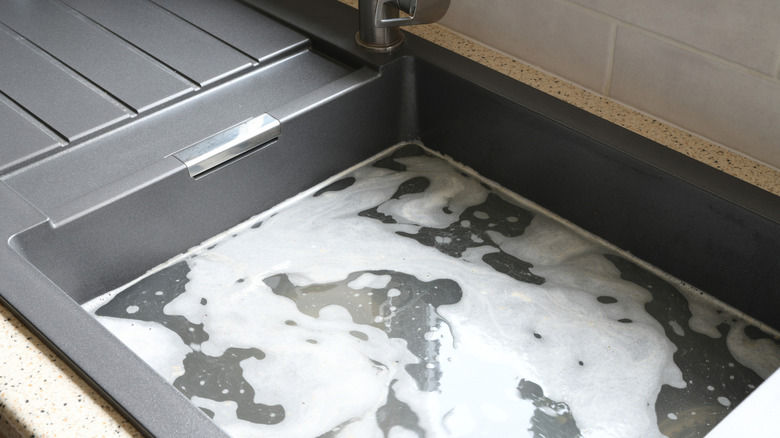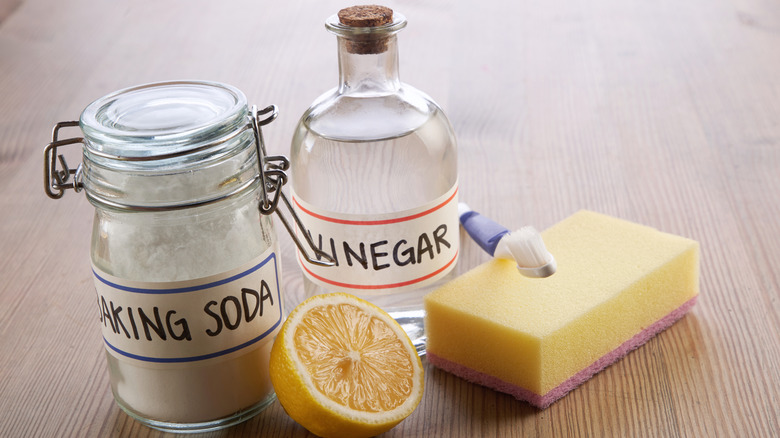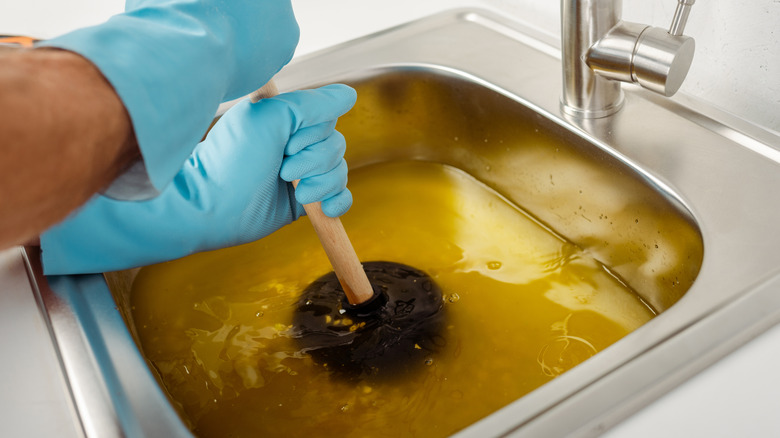My Kitchen Drain Is Clogged And Drano Does Not Work
If your kitchen drain gets clogged, a common solution is to buy some Drano and pour it in. However, while Drano works well for unclogging drains in a lot of cases, you won't always be so lucky. Sometimes, Drano will fail to eliminate a clog – it's not a miracle worker, and some clogs are just too tough. If Drano fails to work, calling a plumber is always a potential solution, but doing so can also be very expensive. Fortunately, there are a few other things to try first besides using Drano or calling a plumber. Other ingredients and plumbing tools may help loosen up a kitchen sink clog, even if Drano has already failed to do the job.
In the future, though, keep in mind that using Drano may not be the best choice anyway. There are some big drawbacks to using Drano and similar products — they can potentially damage pipes through corrosion, and create tiny cracks in the pipes. Drano can also harm the environment as its chemicals flow into your sewer, and potentially, the local water supply. Drano can also stay in your home's pipes for quite a while and this could make it harder to work on them in the future. Contact with Drano is dangerous for pets, kids, and adults, as well as plumbers who may work on your pipes later on.
With all that said, let's now figure out non-Drano way to fix your clog problem.
Unclogging your drain with baking soda and vinegar
If Drano has failed your kitchen sink, you may want to try using baking soda and vinegar to unclog a drain instead. When used together, baking soda, also known as sodium bicarbonate, reacts with the acetic acid in vinegar to help break up the clog. These ingredients will be easier on your pipes than Drano and are safer to handle, since they don't have Drano's harsh chemicals.
To use these ingredients, you'll need to measure out between half a cup and a full cup of baking soda, then pour it down your kitchen sink's drain. Afterward, add half a cup of white vinegar to the drain. You can dilute the vinegar by adding some water to the mix, if you'd like. Then, let both ingredients sit for a minimum of 10 minutes or up to a full hour. After this time has passed, pour boiling water down the drain. If all goes well, you should find that the clog has broken up and your sink's condition has improved. Like Drano, however, these ingredients may not solve your problem, especially if there are fats such as oil, butter, and grease in your pipes. If it fails to work, you'll need to move onto other solutions.
Keep in mind that there are drawbacks to using these ingredients as well, especially if using too much or if you use this method repeatedly. Adding too much baking soda to a drain can cause problems if the ingredient doesn't fully dissolve in your sink. In some cases, it may end up clogging it up further. Vinegar may potentially cause some pipe corrosion if used too often.
Breaking up a kitchen sink clog with common plumbing tools
If both Drano and these natural ingredients fail to work, you may need to get physical. While you likely did so already, be sure that you've tried using a standard cup plunger to unclog your kitchen sink before giving up. These aren't just capable of unclogging toilets, but can help with sink clogs as well. It's also worth trying to plunge the sink after you've already used these other methods, just in case anything has loosened up. Sometimes it's a matter of plunging for longer, so don't stop until you've tried plunging the sink for at least five minutes without seeing any improvement.
If all else fails, you'll also want to try using a drain snake. A drain snake is a long, flexible coil that can be pushed through a drain — the pointy end or hook can be especially helpful for breaking up clogs. You can buy or rent a drain snake from a hardware or home improvement store. Be sure to get one that's a suitable size for your sink. For a kitchen sink drain, you'll likely only need a drain snake that's about 25 feet in length. Before getting started, you may need to disconnect the P-trap barrier underneath your sink. You'll then push the drain snake into the sink and crank the handle once you've noticed resistance. While there's a good chance that this will break up your clog, consider calling a plumber if it fails or if you run into any additional issues.


